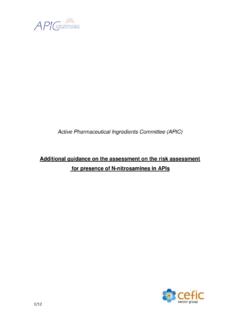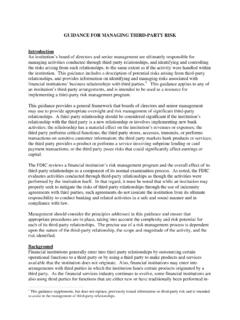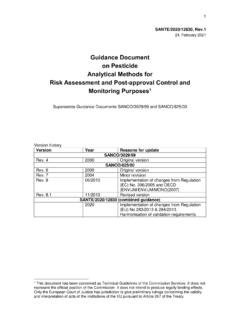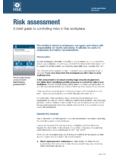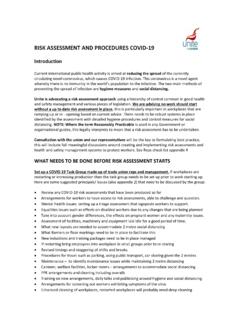Transcription of Risk Assessment in Clinical Trials - DDi
1 Volume 8 Issue 122 Journal for Clinical StudiesRisks are an integral part of Clinical Trials . We routinely come across various risks while managing Clinical Trials which are related to quality, safety, timeline, or budget and they may easily aect the objectives and outcomes of the Trials . Risk management, which involves risk identication, Assessment , planning, tracking and controlling, is an important aspect that one has to look into to ensure successful completion of a Clinical trial. With increased Clinical R & D budgetary constraints and complexities of Clinical Trials , risk management has become an essential piece of Clinical trial management to ensure good return on investment. The core of risk management is the identcation and Assessment of the risks on a continuous basis for risk-bearing activities throughout the planning, conduct and close-out phase of Clinical Assessment in Clinical TrialsA robust risk Assessment process in Clinical Trials forms the foundation for an eective risk management programme.
2 Risk Assessment is a systematic process for identifying and evaluating events that could aect the achievement of Clinical study objectives related to quality, safety, timelines and budget, positively or negatively. After issuance of the guidance on risk-based monitoring by the FDA, sponsors/CROs have demonstrated a keen interest in adopting a systematic approach to risk Assessment in Clinical Trials . It is all about taking a study-spec holistic approach to identify all potential risks and evaluate those risks , to assess the probability of occurrence and impacts. Eective risk action planning involves eective risk identication and proactive root cause analysis. Therefore, it is necessary to thoroughly identify the sources of all potential risks and root causes to improve action planning for better outcomes.
3 A right implementation of a robust risk Assessment process during planning, conduct and close-out of a Clinical trial empowers the study management team to better identify and evaluate the right risks for a Clinical trial, all while maintaining the appropriate controls to ensure eective and ent quality conduct, patient safety and regulatory Assessment Processe the objectives of each category:Identifying objectives of each category or aspect is key in order to achieve the overall goals of the study. The categories may be timelines, safety, quality and budget, etc. For example, in the timelines category, one of the objectives would be meeting expected patient recruitment timelines or achieving regulatory approval as per the planned duration. In safe ty, one of the objectives would be keeping the average SAE rate per subject below the expected value.
4 The other objective could be keeping the dropout rate below the expected number in the protocol in quality category. Once the category and objectives are set, it provides a platform to identify risks or events which may aect the achievements of these objectives. Identify events/ risks which may aect the achievement of the objectives:For complete risk Assessment , one needs to take a holistic approach of risk identcation and Assessment . This requires through Assessment of various internal and external processes, systems, people and technology involved in a Clinical trial, which may pose risks to achievements of the objectives. Clear identication of risk/s which will aect the objective/s is essential for risk planning and controlling action. The table below illustrates some categories with key types of risks which may aect the achievements of the objectives in those categories.
5 Assess the root causes of the events/ risks and tolerance limits:Root cause analysis (RCA) is an important process of risk Assessment and it involves scienti principles. Even formulating a proper risk statement helps to identify the actual risk and root cause. For example, a risk statement could be Because it is a rare disease study, there is a risk Risk Assessment in Clinical TrialsJournal for Clinical Studies the sites may not recruit patients as per the expected rate, resulting in delays in patient recruitment . Another example could be Because the site does not have enough experience in GCP, there is a risk that the site may not follow the protocol correctly, resulting in issues related to data quality . Such a complete risk statement helps to identify the actual risk, root cause and consequences.
6 Identication of right root cause facilitates eective action planning and thereby controlling or mitigation of risks . RCA also supports improving processes/systems to minimise risk or eliminate it completely. As per an FDA guidance document on Oversight of Clinical Investigations A Risk Based Approach to Monitoring , following the identication of critical data and processes, a thorough r isk a ssessment s hould b e p erformed t o i dentify and understand the nature, sources, and potential causes of risks that could aect the collection of critical data or the performance of critical processes. The risks to critical data and processes carry the highest consideration during risk Assessment , to ensure that monitoring eorts are focused on preventing or mitigating important and likely sources of error in their conduct, collection and are acceptable up to certain limits and therefore dening tolerance or threshold will help in deciding trigger points to initiate controlling/mitigation measures during conduct phase.
7 Examples of these tolerance limits or thresholds are given in the table below, which will vary study to the likelihood and impact of the risks :The root cause analysis helps in assessing the risk source further for its chances of occurrence (likelihood) and the impact (consequence) it may have on the study. There are dierent scales to assess the likelihood and impact of the risks . These are based on a 1 to 3 scale or a 1 to 5 scale. The risk matrix given below can facilitate the risk Assessment and action planning process based on the risk score as low, medium, high or extreme. The risks falling into high, very high or extreme categories need right action planning and close monitoring to ensure eective risk control. Risk detectability is another dimension which can be considered in the risk Assessment on severity and scance of risks , decide the risk responses:The risk responses should be planned appropriately based on the risk score and risk signicance.
8 The risk responses and action planning should be done appropriately for high and extreme (critical) risks . The responses could be one of four types Avoid, Transfe r, Accept or Mitigate. An Avoid response could occur if there is any real show-stopper risk, like no approval of Clinical trial by an EC or IRB because of the placebo design of a trial. In such a case, the Clinical trial plan should be reviewed and changed to avoid such a risk. It means probably eliminating such investigational sites from the Clinical study plan. Regarding Transfe r of a risk, if any potential risk response is outside of the sphere of inuence of the team involved, it may be necessary to identify an alternative group to whom the risk could be transfe rred for action or decision-making.
9 An example of an Accept response could be selecting a country for a Clinical trial, even if there is a high chance of a delay in regulatory approval. Even if it is a signicant risk, it is accepted as that country would be very important, maybe because of the pool of patients or future marketing plans. A Mitigate response is very commonly used. Mitigation actions may have one of several objectives, like eliminating the risk completely, minimising the impact of the risk, reducing the likelihood of the risk occurring, or increasing the chances of the risk being detected if it should occur. An example of a Mitigation response could be having an investigational site on a study with less or no GCP experience. This risk can be mitigated by close monitoring of the site or additional training to the Assessment of risks dynamics: risks are dynamic and therefore, risk Assessment should not be limited to only before and during the planning stage, but should also be ongoing during the conduct and closing phases of a trial.
10 There are chances that one risk may give rise to another or multiple risks , or there may be changes or increases in the root causes of a risk. Ongoing Assessment of risk helps to tune risk response and action planning to improve overall risk 8 Issue 124 Journal for Clinical StudiesThe appropriate technology is helpful in making the risk Assessment and management process more ent and eective. As these are dynamic processes, they require the right technology that can catch various aspects and changing scenarios of the risks , to get the right picture of the risks involved. As the industry is moving towards a quality risk management (QRM) or risk-based monitoring (RBM) approach, the market is witnessing the customised tools for risk management catering to the needs of Clinical Trials project/programmes.

